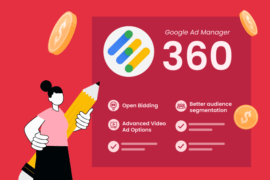Google recently launched web interstitial ads for both desktop and mobile. This is a significant opportunity for publishers to earn additional revenue. As of now, the ad format can be accessed through Google Ad Manager where it has been released as a beta version.
Interstitial ads have always been around to help publishers earn high CPMs. Take for instance Airbnb and Pinterest, for which, the app installations have risen by 300% and 100%, respectively.
In this post, we cover all about interstitial ads and how publishers can use them to optimize their revenue.
What are Interstitial Ads?
Interstitial ads cover the full screen of the device that they are being displayed upon. Normally these ads are used between transitions from one point to another.
A very common example of interstitial ads is the ad that may appear while playing a game on a mobile. The ad will usually appear after playing one or two rounds. An image or rich media ad can be closed instantly. But with a video interstitial ad, the user usually has to wait for a few seconds before they can close it.
The reason for high success rates of these ads is their full coverage offering high ad viewability, which also differentiates them from other ad formats such as banners or native ads.
How to Get Started with Interstitial Ads in GAM?
1. For tagging, the ‘INTERSTITIAL’ GPT slot type has to be added to the <head> element of the page. After this, the ad slot can be displayed in a manner similar to any other ad slot. Publishers should also note that Google Publisher Tag should be running in the top window for supporting web interstitials. Presently, web interstitials are only requested by GPT on pages that are supporting the format properly. This is to make sure that user experience is not hampered.
2. Next comes the trafficking of web interstitial ads. First step is to create ad units or utilize existing ones for interstitial slots. For making sure that trafficking is streamlined, the sizes listed below should be included:
- 320×480 (for desktop, mobile phones, and tablets)
- 300×250 (for desktop and mobile phones)
- 336×280 (for desktop and tablets)
After the creation of ad units, the publisher will have to create line items. In case of reserved inventory, ad creatives must have the above mentioned sizes.
For non-reserved inventory, the publisher can include ad units in the Ad exchange line item and the above mentioned sizes in the associated placeholder creative.
3. For checking up on the performance of interstitials, publishers can use the “inventory format’ dimension.
Note: Web interstitial ads are not available for programmatic direct.
Best Practices
While using interstitial ads, it is highly important to provide optimal user experience because sometimes they can be disrupting. Publishers should refer to the following best practices for the same.
1. Since interstitial advertisements can come off as being intrusive, Google launched a set of standards to be followed when these ads are deployed. The standards were set for ensuring easy access to mobile content. However, they are now applicable for web interstitials as well.
Here is a list of instances where Google may penalize website for using interstitial ads:
- Appearance of an ad immediately after a user visits the website
- Placing of interstitial ads after each action taken by the user
- Serving another ad right after the user closes one ad
- Sudden display of interstitial ads while the user is focusing on a task
However, there are some exceptions, where interstitial ads are not penalized, including:
- Interstitials that are meant for age verifications
- Ads that ask for cookie consent
- Ads that are displayed when the user is navigating between two web pages
2. Another key aspect that needs to be prioritized when using interstitial ads is frequency capping. In order to reduce banner blindness, an ad should not be displayed on the user’s screen repeatedly. For web interstitials, a maximum of one ad per hour per subdomain is the ideal frequency. To enforce this, GAM utilizes local storage for verifying that a web interstitial has not been by the user in the past hour.
3. The user should further be provided with a clear exit option for interstitial ads to ensure enhanced user experience.
4. Lastly, these ads need to pre-load and render automatically before the user navigates away from the page. No delay should be caused as the user is clicking a link on the web page.
What Does This Mean for Publishers?
With the launch of web interstitial ads on GAM, publishers are now provided with yet another ad format to experiment with. As has already been mentioned, these ad formats have been shown to increase CTR and conversion rates, which means higher revenue for publishers. Interstitial ads are already highly popular for mobile devices, and now publishers can leverage them for web browsers as well.
The unique characteristic of interstitial ads is that they amplify ad viewability. If implemented correctly, web interstitials can prove to be highly beneficial for publishers.
Another benefit of Google launching web interstitial ads is that publishers who are directly working with Google Certified Publishing Partners (such as AdPushup) get direct access and support to seamlessly deploy these ads on their inventory.
Final Thoughts
Interstitial ads are innovative and somewhat unconventional ad formats, which can optimize revenue generation. First of all, publishers should figure out if this ad format is ideal for their web page or not. In case of inefficient implementation, interstitials can also decrease conversion rates and traffic.
Therefore, publishers should primarily be concerned with matching Google Search Standards and frequency capping. These factors will ensure that minimum obstruction is caused for the user. Additionally, publishers should adhere to best practices because Google can penalize their website for hampering user experience.

Shubham is a digital marketer with rich experience working in the advertisement technology industry. He has vast experience in the programmatic industry, driving business strategy and scaling functions including but not limited to growth and marketing, Operations, process optimization, and Sales.







